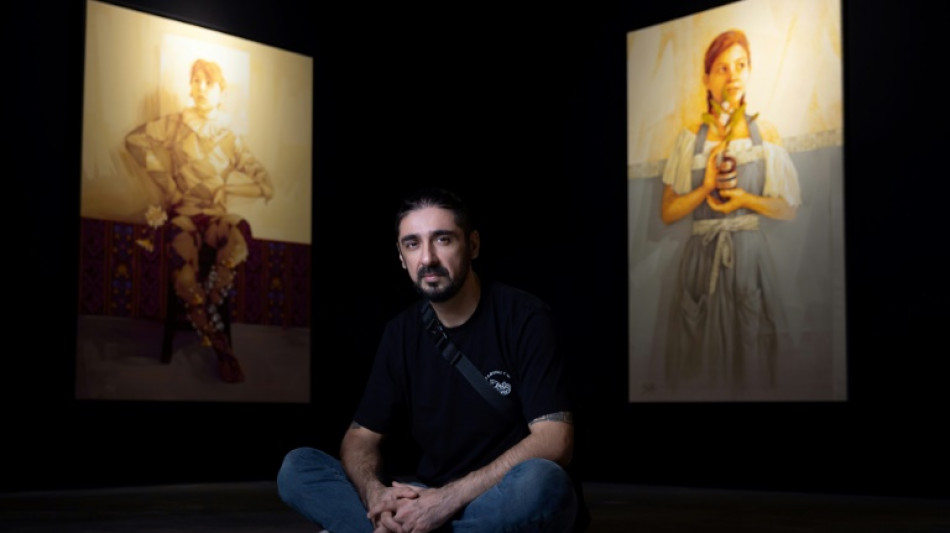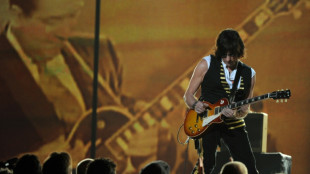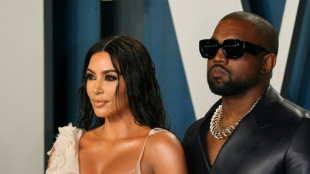
-
 Farmers target PM Starmer in protest against new UK tax rules
Farmers target PM Starmer in protest against new UK tax rules
-
Shiffrin masters Levi slalom for 98th World Cup win

-
 Italy's Donnarumma thankful for Mbappe absence in France showdown
Italy's Donnarumma thankful for Mbappe absence in France showdown
-
McIlroy in three-way tie for Dubai lead

-
 Bagnaia wins Barcelona MotoGP sprint to take season to final race
Bagnaia wins Barcelona MotoGP sprint to take season to final race
-
Ukraine's Zelensky says wants to end war by diplomacy next year

-
 Shiffrin wins Levi slalom for 98th World Cup victory
Shiffrin wins Levi slalom for 98th World Cup victory
-
Israel pummels south Beirut as Lebanon mulls truce plan

-
 Religious Jews comfort hostages' families in Tel Aviv
Religious Jews comfort hostages' families in Tel Aviv
-
German Greens' Robert Habeck to lead bruised party into elections

-
 Johnson bags five as Australia beat Pakistan to seal T20 series
Johnson bags five as Australia beat Pakistan to seal T20 series
-
Zelensky says wants to end war by diplomacy next year

-
 Rugby Union: Wales v Australia - three talking points
Rugby Union: Wales v Australia - three talking points
-
10 newborns killed in India hospital fire

-
 Veteran Le Cam leads Vendee Globe as Sorel is first to quit
Veteran Le Cam leads Vendee Globe as Sorel is first to quit
-
Bagnaia on pole for Barcelona MotoGP, Martin fourth

-
 UN climate chief urges G20 to spur tense COP29 negotiations
UN climate chief urges G20 to spur tense COP29 negotiations
-
Rauf takes four as Pakistan hold Australia to 147-9 in 2nd T20

-
 World not listening to us, laments Kenyan climate scientist at COP29
World not listening to us, laments Kenyan climate scientist at COP29
-
Philippines warns of 'potentially catastrophic' Super Typhoon Man-yi

-
 Wales take on Australia desperate for victory to avoid unwanted record
Wales take on Australia desperate for victory to avoid unwanted record
-
Tyson beaten by Youtuber Paul in heavyweight return

-
 Taylor holds off bloodied Serrano to retain undisputed crown
Taylor holds off bloodied Serrano to retain undisputed crown
-
Japan PM expresses concern to Xi over South China Sea situation

-
 Tens of thousands flee as Super Typhoon Man-yi nears Philippines
Tens of thousands flee as Super Typhoon Man-yi nears Philippines
-
Hoilett gives Canada win in Suriname as Mexico lose to Honduras

-
 Davis, James spark Lakers over Spurs while Cavs stay perfect
Davis, James spark Lakers over Spurs while Cavs stay perfect
-
Mushroom houses for Gaza? Arab designers offer home-grown innovations

-
 Gabon votes on new constitution hailed by junta as 'turning point'
Gabon votes on new constitution hailed by junta as 'turning point'
-
Young Libyans gear up for their first ever election

-
 Vice tightens around remaining civilians in eastern Ukraine
Vice tightens around remaining civilians in eastern Ukraine
-
Dutch coalition survives political turmoil after minister's resignation

-
 Uruguay end winless run with dramatic late win over Colombia
Uruguay end winless run with dramatic late win over Colombia
-
Max potential: 10 years since a teenage Verstappen wowed in Macau

-
 Tens of thousands flee as Typhoon Man-yi nears Philippines
Tens of thousands flee as Typhoon Man-yi nears Philippines
-
Is Argentina's Milei on brink of leaving Paris climate accord?

-
 Big Bang: Trump and Musk could redefine US space strategy
Big Bang: Trump and Musk could redefine US space strategy
-
Revolution over but more protests than ever in Bangladesh

-
 Minister resigns but Dutch coalition remains in place
Minister resigns but Dutch coalition remains in place
-
Ireland won 'ugly', says relieved Farrell

-
 Stirring 'haka' dance disrupts New Zealand's parliament
Stirring 'haka' dance disrupts New Zealand's parliament
-
England's Hull grabs lead over No.1 Korda at LPGA Annika

-
 Kosovo players walk off in Romania after 'Serbia' chants, game abandoned
Kosovo players walk off in Romania after 'Serbia' chants, game abandoned
-
Kosovo players walk off in Romania game after 'Serbia' chants

-
 Lame-duck Biden tries to reassure allies as Trump looms
Lame-duck Biden tries to reassure allies as Trump looms
-
Nervy Irish edge Argentina in Test nailbiter

-
 Ronaldo at double as Portugal reach Nations League quarters, Spain win
Ronaldo at double as Portugal reach Nations League quarters, Spain win
-
Fitch upgrades Argentina debt rating amid economic pain

-
 Trump picks Doug Burgum as energy czar in new administration
Trump picks Doug Burgum as energy czar in new administration
-
Phone documentary details struggles of Afghan women under Taliban


Does street art belong in a museum?
Invaders in the Petit Palais: some 60 of the world's most renowned street artists have been invited into the rarefied confines of a Paris institution, even if some admit it raises questions about whether they belong.
The Beaux-Arts palace on the banks of the Seine houses an illustrious selection of 19th-century painting and sculpture.
But the "We Are Here" exhibition sees the street artists infiltrate it with graffiti, murals and graphics dotted among the portraits -- even adding cartoon wings to statues.
Some merge almost too well -- a freshly made portrait by Tunisian artist DaBro looks perfectly at home in a cluster of solemn 19th-century street scenes until you realise it features break-dancers.
Others are more jarring, such as the pixelated alien by the French artist Invader sitting above a Monet sunset.
It is, say some of the artists, a logical step.
"Street art always has the spirit of invasion. We always want to take over spaces that are not open to us," said Inti, a Chilean artist who provided a huge mural.
But the exhibition has also made him question himself, he told AFP: "To enter into a closed space like this is to enter into an institution -- it's a bit counter to what we try to do outside."
He was concerned, too, that street art has become too commercialised, undermining its rebellious spirit.
A painting by US artist Jean-Michel Basquiat, who started out in street art before moving into galleries, sold for $110 million in 2017; a shredded artwork by Britain's guerilla street artist Banksy went for $25 million in 2021.
Hush, a street artist from the north of England, agrees that art movements die when they become too accepted by the establishment.
But its ethos still challenges the elitist atmosphere of galleries, he said.
"As a working-class guy, you don't always feel accepted in art museums. With street art, everyone feels allowed to come in," he told AFP.
"And you can still be disruptive, you can still have fun. The good thing with being from this scene is you don't feel like you have to say yes. It means we're still in control."
- 'Buried underground' -
One of the first items to strike visitors is a giant aerosol can emerging out of the ground with cartoon wings, courtesy of London-based artist D*Face.
"It represents the fact that we've been buried underground and often overlooked and now we're coming up to be seen," he said.
The timing is right, he added, with France plunged into political turmoil this week by a far-right landslide in European elections.
"Urban art is really the first global art movement. You go anywhere in the world and there is a street art community," said D*Face.
"It's all about inclusivity, whereas politics right now is trying to divide us."
Also present is Shepard Fairey, aka Obey, renowned for his "Hope" posters for Barack Obama's presidential campaign.
His "Liberty, Equality, Brotherhood" shows French figurehead Marianne with a blood-red tear running down her cheek, made in response to terrorist attacks in Paris in 2015.
"The thing I love about street art is that it brings people together, it's got a generous spirit," he said. "Anything that makes people think about their common humanity rather than selfish protectionism is very valuable for this moment."
But can street art maintain that political relevance if it becomes too accepted by the elite?
"We've been saying street art is dead since its inception and it has kept evolving," said Hush.
"But it has come full circle. Street art was against the people who could say yes or no.
"And now they say yes to us."
F.Wilson--AT




